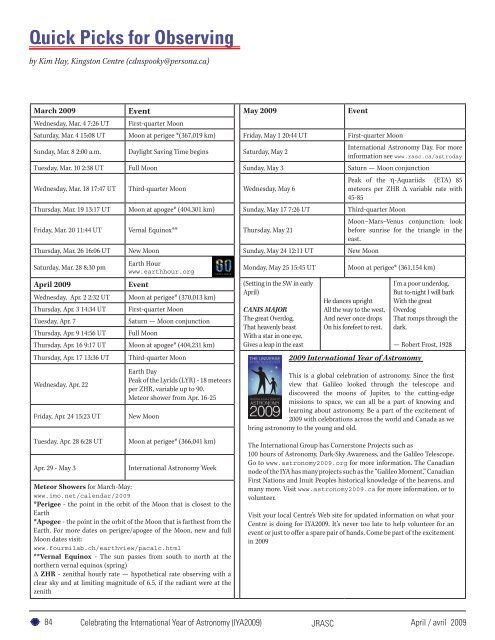Moment
insidethisissue - The Royal Astronomical Society of Canada
insidethisissue - The Royal Astronomical Society of Canada
Create successful ePaper yourself
Turn your PDF publications into a flip-book with our unique Google optimized e-Paper software.
Quick Picks for Observingby Kim Hay, Kingston Centre (cdnspooky@persona.ca)March 2009 Event May 2009 EventWednesday, Mar. 47:26 UT First-quarter MoonSaturday, Mar. 415:08 UT Moon at perigee *(367,019 km) Friday, May 120:44 UT First-quarter MoonSunday, Mar. 82:00 a.m. Daylight Saving Time begins Saturday, May 2International Astronomy Day. For moreinformation see www.rasc.ca/astrodayTuesday, Mar. 102:38 UT Full Moon Sunday, May 3 Saturn — Moon conjunctionPeak of the η-Aquariids (ETA) 85Wednesday, Mar. 1817:47 UT Third-quarter Moon Wednesday, May 6meteors per ZHR ∆ variable rate with45-85Thursday, Mar. 1913:17 UT Moon at apogee* (404,301 km) Sunday, May 177:26 UT Third-quarter MoonFriday, Mar. 2011:44 UT Vernal Equinox** Thursday, May 21Moon–Mars–Venus conjunction: lookbefore sunrise for the triangle in theeast.Thursday, Mar. 2616:06 UT New Moon Sunday, May 2412:11 UT New MoonSaturday, Mar. 28 8:30 pmApril 2009Wednesday, Apr. 22:32 UTThursday, Apr. 314:34 UTTuesday, Apr. 7Thursday, Apr. 914:56 UTThursday, Apr. 169:17 UTThursday, Apr. 1713:36 UTWednesday, Apr. 22Friday, Apr. 24 15:23 UTTuesday, Apr. 28 6:28 UTApr. 29 - May 3Earth Hourwww.earthhour.orgEventMoon at perigee* (370,013 km)First-quarter MoonSaturn — Moon conjunctionFull MoonMoon at apogee* (404,231 km)Third-quarter MoonEarth DayPeak of the Lyrids (LYR) - 18 meteorsper ZHR, variable up to 90.Meteor shower from Apr. 16-25New MoonMoon at perigee* (366,041 km)International Astronomy WeekMeteor Showers for March-May:www.imo.net/calendar/2009*Perigee - the point in the orbit of the Moon that is closest to theEarth*Apogee - the point in the orbit of the Moon that is farthest from theEarth. For more dates on perigee/apogee of the Moon, new and fullMoon dates visit:www.fourmilab.ch/earthview/pacalc.html**Vernal Equinox - The sun passes from south to north at thenorthern vernal equinox (spring)∆ ZHR - zenithal hourly rate — hypothetical rate observing with aclear sky and at limiting magnitude of 6.5, if the radiant were at thezenithMonday, May 25 15:45 UT(Setting in the SW in earlyApril)CANIS MAJORThe great Overdog,That heavenly beastWith a star in one eye,Gives a leap in the eastMoon at perigee* (361,154 km)He dances uprightAll the way to the west,And never once dropsOn his forefeet to rest.2009 International Year of AstronomyI’m a poor underdog,But to-night I will barkWith the greatOverdogThat romps through thedark.— Robert Frost, 1928This is a global celebration of astronomy. Since the firstview that Galileo looked through the telescope anddiscovered the moons of Jupiter, to the cutting-edgemissions to space, we can all be a part of knowing andlearning about astronomy. Be a part of the excitement of2009 with celebrations across the world and Canada as webring astronomy to the young and old.The International Group has Cornerstone Projects such as100 hours of Astronomy, Dark-Sky Awareness, and the Galileo Telescope.Go to www.astronomy2009.org for more information. The Canadiannode of the IYA has many projects such as the “Galileo <strong>Moment</strong>,” CanadianFirst Nations and Inuit Peoples historical knowledge of the heavens, andmany more. Visit www.astronomy2009.ca for more information, or tovolunteer.Visit your local Centre’s Web site for updated information on what yourCentre is doing for IYA2009. It’s never too late to help volunteer for anevent or just to offer a spare pair of hands. Come be part of the excitementin 200984 Celebrating the International Year of Astronomy (IYA2009)JRASC April / avril 2009
















